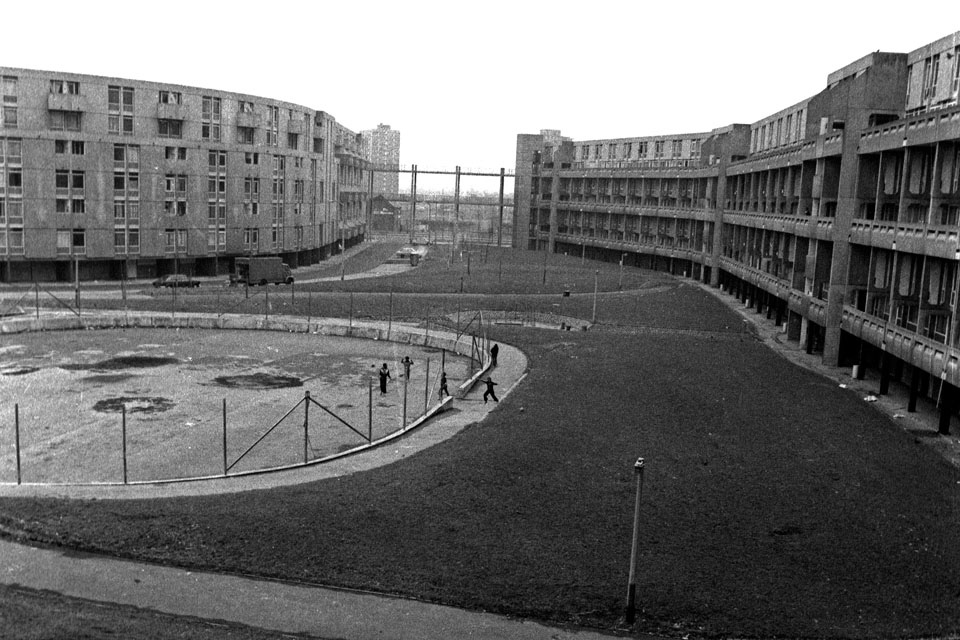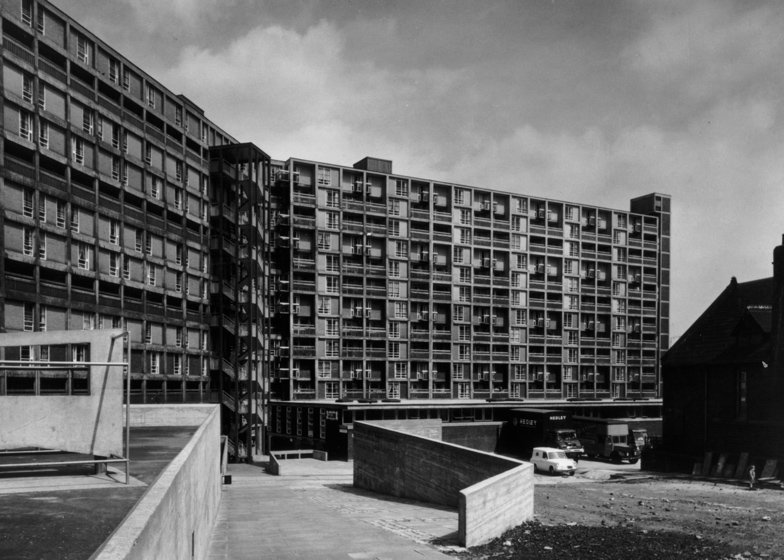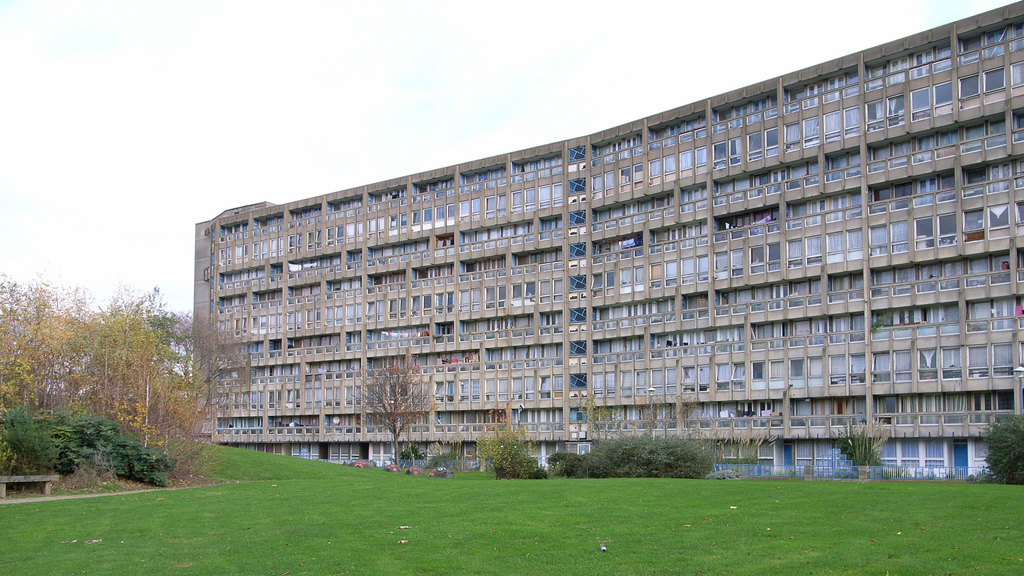British post-war mass housing
Contents |
[edit] Introduction
This article focuses on housing constructed during the decade or so after the end of the Second World War as part of the progressive, experimental establishment of the Welfare State in Britain.
Housing provision by the end of the war, particularly in urban centres, was considered inadequate, not only in quantity, but in quality as well. War damage had impacted on the quantity of housing stock, but additionally, much ‘obsolete’ housing had been earmarked for demolition before the war.
Nicholas Taylor, writing in the AR in 1967, in a discussion of what he called ‘the failure of housing’ in the postwar period, cites the ‘...negative [post-war] reaction to the boom towns of the industrial revolution’ as the reason for this.
‘In particular’, he says, [we] ‘...have aimed to prevent epidemic diseases cholera, dysentery, rickets, scurvy, typhoid’, all diseases which were ‘propagated by overcrowding, by bad sanitation, by inadequate facilities for the preparation of food and by the pollution of homes from adjoining factories.’
It is important to understand that the politically progressive nature of housing policy in the period, embedded as it was in the establishment of the Welfare State, was “...based on the principles of, equality of opportunity, equitable distribution of wealth, and public responsibility for those unable to avail themselves of the minimal provisions for a good life.”(1)
Architecturally, the modernist desire expressed by Le Corbusier was to “...provide an environment that was spiritually fulfilling, creating harmony between people and their surroundings and freeing communities from the misery of poor housing” (2).
This was perfectly in sync with the prevailing political commitment to decisively break away from unsanitary, overcrowded slums.
There were a handful of iconic and notorious case studies of 50’s and 60’s mass housing, that polarised opinion and acted as symbols for the wider debate.
[edit] Park Hill
Park Hill in Sheffield was built in 1960, and according to the Architectural Review (in 2011) “...marked the peak performance of Sheffield’s city architects office as run by J.K. Lewis Womersley, regarded by [Nikolaus] Pevsner as an outfit of national importance.” (3)
This building “...proved popular with its residents, who loved their flats and soon formed an effective association. It was also much lauded in architectural circles… Its size and hillside location made it the prime example of ‘streets in the air’ nationally, and for a decade or so it thronged with international visitors." (4)
Following the election of a Conservative government in May 1979, the withdrawal of subsidies for nationalised industries, subsequent unemployment and introduction of right to buy, decline set in “...as the ideal of equality was eroded [and] social housing became the ghetto of a suppressed underclass, and the more active, capable and employed were encouraged to buy themselves out, leaving the disadvantaged in possession.”
A recent initiative to redevelop the building provoked fresh debate. A blog on the Guardian website (5) typified the views expressed:
“...As a 'foreigner' from Leeds who has lived in Sheffield for 30 years I can support those who report that the people of Sheffield did not want Park Hill kept, and were mystified by the listing and bemused by the amounts of money, some of it public money, being spent on this eyesore. The bright coloured panels are not an improvement. Anyone in Sheffield with the money to buy one of the penthouses would be much better advised to spend it in one of Sheffield's leafy and affluent suburbs, of which we have many, which also often enjoy superb views, as Sheffield is very hilly.”
This neatly expresses the popular view of dense, large scale urban social housing projects of the period, in which as long ago as 1967, “...It [was] easier to count the few unbroken panes of armoured glass on the staircases than the multitude which are cracked and splintered”, and where “...economy on materials and inadequacy of detailing can be assessed as objective weaknesses, but what is perhaps more important… is the subjective hatred of the tenants for the rough shuttered concrete that is thrust upon them.” (6)
Descriptions of inhumane proportions, ‘undefined wastes’, and, “women return[ing] from the shops to be blown about amid the appalling dinginess of rough shuttered concrete" (7) crop up again and again in discussions about schemes like Park Hill, Robin Hood Gardens, Red Road etc.
The belief in the preferability of 'leafy and affluent suburbs' to dense urban apartment typology also reflects a lingering psychological scar in the popular psyche left by the memory of the descent of estates like Park Hill “...from source[s] of intense municipal socialist pride to dilapidated sink estate[s]” (8), as though by their very nature they preclude the presence of a functional, prosperous community.
This is in stark contrast to surveys at Park Hill that “ show that through the 1970’s residents remained consistently loyal and generally happy.” (9)
The home-building drive, founded on the vision of spiritually uplifting accommodation for all, continued, but “…the vision was damaged by lack of reform in the 1960s. Rather than opening up [the] low cost-balanced rented sector to supply the needs of a more wealthy and mobile population, it narrowed to serve the restricted needs of welfare housing.” (10) This precipitated a vicious circle of decline.
The 60’s was a period of economic optimism, in which comparative affluence was accessible to an increasing number of families. An aspirational desire grew among those in social housing to graduate to home ownership.
“Very large council estates, tower blocks in the cities and restrictive letting policies contrasted with the variety of choices available for home ownership. From the 1960’s, the welfare characteristic (residualisation) of council housing began to develop as a stigma from which home ownership was the natural escape.” (11)
The original dream of social housing as “a living tapestry of a mixed community” (12) was replaced by welfare housing, which established a low cost rented stock but created deep social problems.
Pre-war restrictions, limiting public housing to the working classes had been repealed in the 1949 Housing Act, opening up a universally accessible rented council house sector. But as this 'public housing' became 'welfare housing', a vicious circle of decline set in. With Park Hill and its cousins populated increasingly by those on welfare, ‘...financial structures of dependency’ [were] deliberately imposed on social housing” (13) and an alienated quality grew as residents of the schemes were cast adrift.
A further strand to this narrative was playing out in the form of a shift in the structure of the economy in Britain. “Sheffield grew up producing steel, in the 18th century knives and tools, in the 19th century heavy industry, with a high population of low paid but skilled manual workers.”
As the 1970’s drew to an end, the shift in policy away from the provision of affordable social housing accelerated against a backdrop of an increasingly deindustrialised economy. The original inhabitants of the Park Hill and schemes like it, who had once been a proud working class, found themselves without the prospect of employment.
In the public imagination, the built fabric of the postwar years not only became synonymous with social failure and breakdown, it was perceived as a cause of it.
NB: In July 2013, the revamped Park Hill was short-listed for the prestigious RIBA Stirling Prize which celebrates the year's top buildings.
[edit] Robin Hood Gardens
Robin Hood Gardens is a serpentine, high density block, this time inserted into an area of bomb damaged terraces (the standard grain of working class England) in London.
“What the Smithsons [architects] wanted to achieve was intended to maintain community dynamics [of the bombed out terraces] rather than to replace them with something entirely different. However, what they had not expected, as Kenneth Frampton pointed out in his book 'Modern Architecture, a Critical History', was that three principal features of the by-law street would be absent in their proposed blocks (14):
- The dynamics associated with dwellings on both sides of a street.
- The community life associated with the street at ground level.
- The backyard.
Robin Hood Gardens, then, contained inherently flawed logic. But these flaws were shared by Park Hill, which prospered during a period when it wasn’t handicapped by other factors.
“[Park Hill] is commonly described as the ‘largest listed building in Europe’ and the largest listed brutalist or 60’s building. In fact”, says Owen Hatherley, “...it's none of those things, with all those titles being taken by London's Barbican estate: a place that, like Park Hill, is full of bare concrete, open space, urban density, walkways, social and the separation of pedestrian and car.
"One is a problem that apparently had to be solved; the other one of London's most prestigious addresses. Why? The obvious reason is that one is council housing and the other, from the very start, was built as private housing. Accordingly, the Barbican has always been cleaned and cared for; Park Hill has been left to rot." (15)
[edit] Modern comparisons
Park Hill is also similar to many of today’s ‘luxury’ apartment developments. The recent speculative redevelopments of inner cities have been described as “... the new ruins of Great Britain. These places have ruination in abundance: partly because of the way they were invariably surrounded by the derelict and un-regenerated, whether rotting industrial remnants or the giant retail and entertainment sheds of the 80s and 90s; partly because they were often so badly built, with pieces of render and wood frequently flaking off within less than a year of completion; but partly because they were so often empty, in every sense.
"Empty of architectural inspiration, empty of social hope or idealism, and often empty of people, Clarence Dock and Glasgow Harbour had a hard time filling their minimalist microflats with either buyers or buy-to-let investors.” (16)
Although marketed and branded differently, contemporary developer led, aspirational urban regeneration, may in fact suffer from similar problems relating to its context as the maligned social schemes of the postwar period. Think of Glasgow Harbour, stranded by the Clyde and cut off from the city by the Clydeside Expressway, and with worse space standards than 1960’s schemes.
“The logic was straightforward” says the Architectural Review in its analysis of Park Hill’s original planning principles: “a slab block up to 13 storeys high and about 10 m wide would permit a habitable room each side and centrally serviced bathrooms, while gallery access was preferred to a double loaded corridor. By making maisonettes with internal staircases it was possible for one gallery to serve 3 floors.
"Greatest design ingenuity went into planning interlocking flats of different sizes, making best use of the limited space…. [space standards] now seem generous, in relation to the products of mass house builders” (18). This, they note, is “still valid logic” if you accept the inevitability of flats for high densities in urban situations.
Even much admired contemporary schemes, like the Panter Hudspith development at Bear Lane in London, feature double loaded internal deck access, permitting only single aspect flats, with cramped accommodation – yet their skin is considered attractive, and they are praised, despite inferior circulation and planning principles.
Park Hill is no simple monolith inserted carelessly into Sheffield. Its very form is a response to specific topography, with its horizontal roof datum capping a 13 storey structure at the bottom of the hill and nuzzling into a street of Victorian villas at four storeys at the top.
The fact that mass social housing in Britain ultimately failed is, in the end, not due to design, but to policy.
[edit] Related articles on Designing Buildings
- Adam Curtis - The Great British Housing Disaster.
- Ballymun mass housing and regeneration.
- Barlow report.
- Boom Cities: architect-planners and the politics of urban renewal in 1960s Britain.
- Brutalism.
- Courtyard.
- Housing market.
- Housing stock / building stock.
- 'England's Post-War Listed Buildings'.
- Garden cities.
- Housing contribution to regeneration.
- Milton Keynes.
- Modernist Estates - Europe: the buildings and the people who live in them today.
- Municipal Dreams: the rise and fall of council housing.
- New Town Development Corporation.
- New towns heritage.
- Nikolaus Pevsner.
- Off-site construction.
- Off-site prefabrication of buildings: A guide to connection choices.
- Pocket door.
- Post-war new towns in Germany.
- Prefabrication.
- Ronan Point.
- Space, Hope and Brutalism.
- Terraced houses and the public realm.
- The Housing Stock of The United Kingdom.
- The structural condition of Easiform cavity-walled dwellings (BR 130).
- Town and Country Planning Act.
- Urban decay.
- Whittington Estate.
[edit] External references
- (1) Britannica Online Encyclopedia
- (2) Architectural Review p114
- (3) Architectural Review, October 2011, referencing Pevsner, Nikolaus, Yorkshire West Riding (buildings of England), Penguin, Lonfon, 1967 pp446-449
- (4) AR pp94
- (5) http://www.guardian.co.uk/artanddesign/2011/aug/21/park-hill-sheffield-renovation
- (6) Taylor, Nicholas, writing in the Architectural Review, October 1967
- (7) AR Nov 1967: review of Hutchesontown-Gorbals, Sir Basil Spence, Glover and Ferguson, 1961-1965
- (8) Hatherley, Owen: A Guide to the New Ruins of Great Britain
- (9) Steve Parnell, Building Design, September 9th, 2011
- (10) www.thereadyfamily.com/housing/Visions_2.htm
- (11) www.thereadyfamily.com/housing/Archive/PostWar.htm
- (12) Aneuren Bevan, Deputy Leader of the Labour Party, 1959-60
- (13) www.hereadyfamily.com/housing/Archive/PostWar.htm
- (14) Clement, Alexander: Postwar British Architecture: Brutalism. Ch6 Social and Private Housing
- (15) Hatherley, Owen: http://www.guardian.co.uk/commentisfree/2011/sep/28/sheffield-park-hill-class-cleansing
- (16) Owen Hatherley, The New Ruins of Great Britain
- (17) Architectural Review, 2011, pp86
- (18) Clement, Alexander: Postwar British Architecture: Brutalism. Ch6 Social and Private Housing
IHBC NewsBlog
Old Sarum fire in listed (& disputed) WW1 Hangar - Wiltshire Council has sought legal advice after fire engulfed a listed First World War hangar that was embroiled in a lengthy planning dispute.
UK Antarctic Heritage Trust launches ‘Virtual Visit’ website area
The Trust calls on people to 'Immerse yourself in our heritage – Making Antarctica Accessible'
Southend Council pledge to force Kursaal owners to maintain building
The Council has pledged to use ‘every tool in the toolbox’ if urgent repairs are not carried out.
HE’s Research Magazine publishes a major study of the heritage of England’s suburbs
The article traces the long evolution of an internal programme to research 200 years of suburban growth
IHBC Context 183 Wellbeing and Heritage published
The issue explores issues at the intersection of heritage and wellbeing.
SAVE celebrates 50 years of campaigning 1975-2025
SAVE Britain’s Heritage has announced events across the country to celebrate bringing new life to remarkable buildings.
IHBC Annual School 2025 - Shrewsbury 12-14 June
Themed Heritage in Context – Value: Plan: Change, join in-person or online.
200th Anniversary Celebration of the Modern Railway Planned
The Stockton & Darlington Railway opened on September 27, 1825.
Competence Framework Launched for Sustainability in the Built Environment
The Construction Industry Council (CIC) and the Edge have jointly published the framework.
Historic England Launches Wellbeing Strategy for Heritage
Whether through visiting, volunteering, learning or creative practice, engaging with heritage can strengthen confidence, resilience, hope and social connections.

















Comments
To start a discussion about this article, click 'Add a comment' above and add your thoughts to this discussion page.